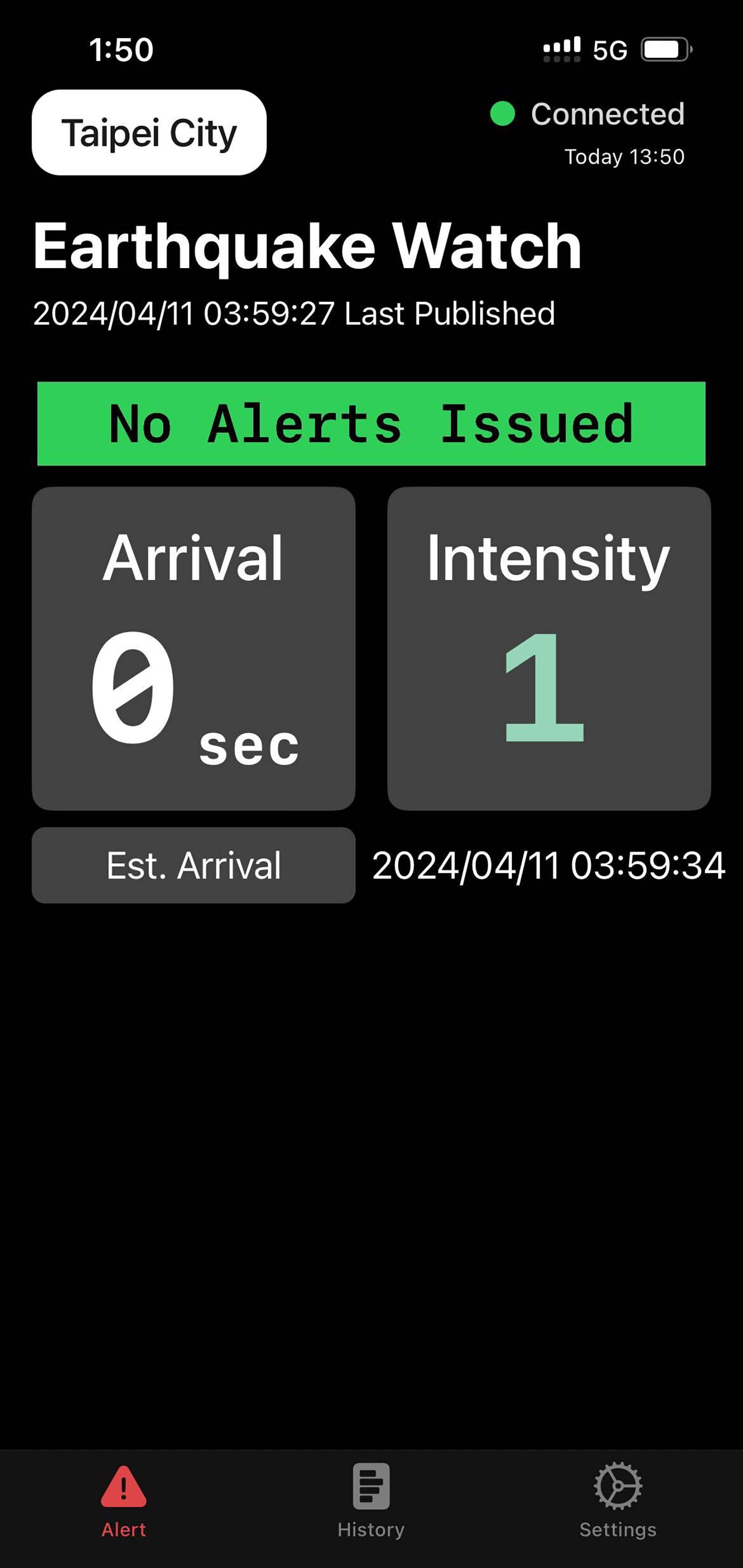18-year-old high school student develops Taiwan's most popular earthquake app

Source:Lin Chih-ping
An app called Taiwan Earthquake Alert accumulated over 300,000 downloads within a week following a major earthquake. The app is the product of one high school student’s self-taught efforts. How did he do it?
Views
18-year-old high school student develops Taiwan's most popular earthquake app
By Li Hsun Tsaiweb only
Following the powerful earthquake that hit Taiwan on April 3, an app called Taiwan Earthquake Alert exploded in popularity on Apple’s App Store.
In just one week, it accumulated over 300,000 downloads, jumping to first among the ranks of free apps for iOS users, even surpassing the popular social media platform Threads.
Users can configure the app to issue alerts for tremors of a particular magnitude. After receiving an alert, the app simply indicates two data points: the magnitude of the quake, and the number of seconds expected before its arrival, providing sufficient warning for users to choose the right method to take shelter.
Although Earthquake Alert utilizes data from the Central Weather Administration, in contrast to national-level alerts, which are only issued for tremors of 4.0 magnitude and higher, the app’s default setting is 3.0. Accordingly, for the residents of seven counties and cities in northern Taiwan, including Taipei City and New Taipei, who did not receive warnings prior to the April 3 quake, installing the app is more practical than relying on national-level alerts. According to back-end data, 70 percent of new users who installed the app over the past week reside in Taipei City.
The app is the brainchild of 18-year-old Lin Tzu-yu.
Inspired by earthquake at the age of nine
Lin Tzu-yu is a high school junior at the Kang Chiao International School’s, Xiugang campus.
Two summers ago, just before his sophomore year, he began working on an earthquake alert system out of personal interest, taking a year to develop the Earthquake Alert app. The app’s default setting for reporting earthquakes is lower than that of the national warning system due to the concern that those living in tall buildings or mountainous regions could be impacted by falling objects or rocks in an earthquake. Accordingly, he reasoned, such people need a lower reporting threshold.
This belief is related to his childhood experience. When he was in third grade, a 6.4-magnitude earthquake struck Hualien, also affecting the northern region of Taiwan. To a nine-year-old boy, this natural phenomenon was both fascinating and frightening. After school, he and his classmates were abuzz with talk about the earthquake and the damage it wrought that day. This marked the start of his interest in earthquake data.
Afterward, he began downloading and tracking various earthquake apps both domestically and internationally, studying earthquake reports. When a typhoon approached, he would also share the typhoon's predicted path and rainfall volume with his parents, reminding nearby friends and relatives to be prepared.
"Looking at forecast maps for typhoon paths or rainfall gives me a sense of security," explains Lin, acknowledging that natural disasters are unavoidable, but their impacts can at least be anticipated.
In the eyes of his father, Lin Chih-ping, a distinguished professor of civil engineering at National Yang Ming Chiao Tung University, Lin Tzu-yu has revered the power of nature from a young age, and is deeply fascinated by it.
 Interface of Taiwan Earthquake Alert app.
Interface of Taiwan Earthquake Alert app.
Learning how to code from YouTube
Upon entering junior high school, Lin's interest in the sciences became increasingly clear, and his father sent him to attend courses on programming languages such as Python and Java. In high school, he recalled seeing a domestic earthquake alert app when he was in elementary school, which had soon been taken down. And although there was an earthquake alert app called "KNY" for Android systems, there were no similar apps for Apple iOS. So he took it upon himself to try and develop one.
Lin’s initial forays did not go smoothly. Swift, the programming language for developing Apple system apps, was unfamiliar territory for him. Lin resorted to learning by watching YouTube tutorials and seeking help on forums whenever he encountered problems.
However, as most of the users on the forums were professional programmers, few were willing to answer Lin’s “newbie” questions, and some even “downvoted” his questions. Undeterred, he continued his quest, also contacting the developers of similar apps to ask for counsel on difficult issues.
Life-saving app hosted on bare-bones server
Initially, Lin used a Raspberry Pi he bought when he was younger to function as the server for his app. Developed as a microcomputer for instructional purposes, the Raspberry Pi system was unfortunately ill-equipped to meet the operational demands of the app. Consequently, when it was first set up, only users located in Taipei City could receive warnings.
Lin’s father felt that, given its objective in providing earthquake warnings, it should be available for people besides residents of Taipei to use. So he offered his son a computer better suited to the task as a server, thus expanding the range of service to eight counties and cities.
The earthquake alert app was launched to a lukewarm reception last summer, up until the recent powerful earthquake sparked a surge in downloads, bringing with it opportunities to improve the app. When Lin initially tested the app, he only had his own iPhone 11 and his father's iPhone 12 to use. It was only after reaching 300,000 users did he realize that iPhone 13 (and higher) users might not be receiving notifications.
“Even a one-star rating is motivation for me in the development of this app,” says Lin, who reads every rating, turning criticism into expectation, emphasizing that as more and more people trust his service, he feels responsible for making the app better.
With this in mind, he plans to dedicate efforts to optimization, such as adding background automatic positioning features, and applying to Apple for authorization so that when phones are set to silent or do not disturb mode, users can still receive audible alerts when earthquakes of a certain magnitude are imminent.
Lin also plans to propose a plan for cooperation with the Central Weather Bureau, directly linking the app to the bureau's earthquake monitoring station data to make the app’s data reporting more real-time and expand its service range to cover all counties and cities in Taiwan.
“It always seems impossible until it’s done.” These are the words, quoted from the late South African President Nelson Mandela, that Lin Chin-ping used to encourage his son.
Observing his child's journey from stumbling to achieving results, as an educator, Lin Chih-ping observes that Taiwan's education system often expects children to achieve growth within the same template. Although Lin Tzu-yu’s grades do not rank him at the top, his father believes that if children can find something in which they are willing to invest their efforts, parents should encourage them to pursue their goals. Thus he never intervened in his son’s app development process.
 Lin Tzu-yu and his families. (Source: Lin Chih-ping)
Lin Tzu-yu and his families. (Source: Lin Chih-ping)
Lin Tzu-yu has already been accepted to the electrical engineering and related departments of several American universities, and will head to the U.S. this coming summer.
Quoting something his father once told him, Tzu-yu says, “You have to get started to be great; you don’t have to be great to get started.”
“I’m an example of that, really starting from scratch to accomplish this,” he says. Looking ahead, Lin Tzu-yu hopes that more regular people will get involved in disaster preparation and preparedness technology. And he hopes to encourage more people to take that courageous first step to pursue their passions.
Have you read?
- Chi Pang-yuan: Emissary of Taiwanese literature, daughter of the Republic of China
- Yuan Yung-cheng: Taiwan’s first soccer pro in Europe
- How golf champion Yani Tseng faced her inner demons
Translated by David Toman
Edited by TC Lin
Uploaded by Ian Huang






